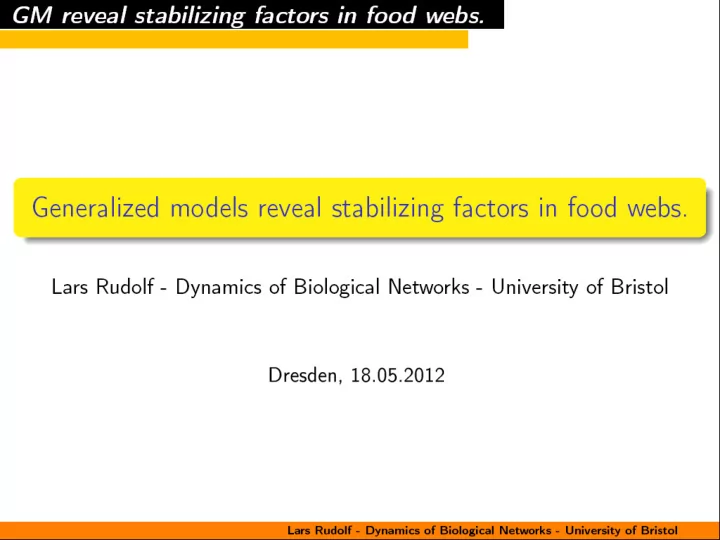

Food webs - The Who eats Who in Ecology. Nodes: Species Links: predator-prey interactions
Food webs - The Who eats Who in Ecology. Directed biomass flows from prey to predator Strong links: High biomass flow Weak links: Low biomass flow
Food webs - The Who eats Who in Ecology. Top predators Trophic gradient Intermediate consumers Primary producers
Complexity or stability?! Large and complex Large and complex systems are in general systems are in general unlikely to be stable ! * unlikely to be stable ! * * May R. Will a large complex system be stable? Nature 238 1972
Complexity or stability?! The majority of The majority of natural food w ebs natural food w ebs Large and complex Large and complex are large, complex, are large, complex, systems are in general systems are in general and stationary and stationary unlikely to be stable ! * unlikely to be stable ! * on population dynamical on population dynamical time scales. time scales. * May R. Will a large complex system be stable? Nature 238 1972
Complexity or stability?! The majority of The majority of natural food w ebs natural food w ebs Large and complex Large and complex are large, complex, are large, complex, systems are in general systems are in general and stationary and stationary unlikely to be stable ! * unlikely to be stable ! * on population dynamical on population dynamical time scales. time scales. What are the properties of food webs which give them their unusual stability? * May R. Will a large complex system be stable? Nature 238 1972
Food webs: - large and complex networks - many variables - many parameters - little informations - strong nonlinearities - dynamics on different time scales
Generalized Models * * Gross T. and Feudel U.: Generalized models as a universal approach to the analysis of nonlinear dynamical systems PHYSICAL REVIEW E 73 , 016205 2006
µ
µ µ µ
µ Rate of biomass turnover Sensitivity of production or loss on species density µ µ
Use an algorithm to create realistic topologies ( The Niche Model* ) * Williams R.J . & Martinez N.D. Simple rules yield complex food webs Nature 404 2000
Results * Thilo Gross, Lars Rudolf, Simon A. Levin and Ulf Dieckmann: Generalized Models Reveal Stabilizing Factors in Food Webs Science 325 , 747 (2009)
Complexity and stability
Weak links: “ Amount of weak links ” - low flow interactions - prey centric normalization Stabilizing for small w ebs, but destabilizing for larger (realistic size) w ebs.
“ trophic size ” ?
“ trophic size ” ?
Conclusion
Conclusion
We reproduce: New results: New results:
We reproduce: New results: New results:
We reproduce: New results: New results:
We reproduce: New results: New results:
We reproduce: Thank you for your attention. New results: New results:
“Complexity” Proportion of stable webs “Stability” Connectance times species number
Recommend
More recommend